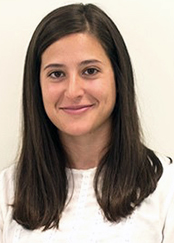Featured Postdoc Research

The molecular mechanisms of cardiac pacemaking
Adina Hazan, Postdoctoral Scientist
Project Summary
Healthy cardiac pacemaking relies on the Atrio-ventricular Node (AVN) as a gateway between the Sino-atrial Node (SAN) generating spontaneous firing and ventricular muscle depolarization which leads to contraction. The AVN interjects a critical delay before propagating the SAN signal and can provide backup spontaneous pacemaking, should the SAN fail. AVN disease is responsible for more than 200,000 deaths per year, yet due to its small size and indeterminate anatomical position, much of the molecular basis of AVN pacemaking remains unclear.
Previous studies in our lab have explored the role of the Sodium-calcium exchanger (NCX) in the SAN through atrial-specific NCX knock out mice and have characterized alternative ionic channels and their function through insights gathered from these mice. In continuation, we are now using these NCX knock out mice to characterize the molecular basis of pacemaking in the AVN. Our findings provide evidence for the necessity of NCX in normal AVN pacemaking and conduction.
Expected Outcomes
Through a suite of techniques used to visualize calcium handling and electrical signaling, we can understand the important adaptations that occur in the absence of NCX. In doing so, we hope to expose novel targets or mechanisms that may prove to be useful in the treatment of cardiac conduction disease.
Key Collaborators
Michela Ottolia, PhD - Associate Professor in Residence of Anesthesiology and Perioperative Medicine, UCLA
Kenneth Philipson, PhD - Professor Emeritus, Physiology, UCLA
Any Labs or Departments associated with research—this would promote further visibility across Cedars-Sinai

Role of mitochondrial MATa1 in alcoholic liver disease
Lead: Lucía Barbier Torres, Postdoctoral Scientist
Project Summary
Lucía Barbier Torres, PhD, received her doctorate at the University of the Basque Country, Spain, in molecular biology and biomedicine. She joined the Lu Laboratory at Cedars-Sinai in 2017 as a postdoctoral scientist to continue her studies on mitochondrial function, signaling pathways and new molecular mechanisms in liver disease.
Project Summary: Despite major advances in alcoholic liver disease (ALD), there is still no effective therapy besides abstinence and uncovering novel molecular mechanisms of its pathogenesis that can lead to novel treatments to prevent its progression are urgently needed. MATa1 catalyzes the synthesis of SAMe, the main biological methyl donor in the liver. Lower MATa1 activity and SAMe levels are associated with liver diseases including ALD, a condition characterized by mitochondrial dysfunction. Until recently, MATa1 was known as a cytosolic and nuclear protein but it also localizes in mitochondria of hepatocytes where it regulates their function. We have shown that mitochondrial MATa1 is specifically reduced in ALD through a mechanism that involves the isomerase PIN1. Alcohol induces MATa1 phosphorylation and interaction with PIN1, thereby inhibiting its mitochondrial translocation. Blocking PIN1-MATa1 interaction increased mitochondrial MATa1, which improved mitochondrial function and protected against alcohol hepatotoxicity.
Expected Outcomes
This work demonstrates that mitochondrial MATa1 protects hepatocytes and that targeting PIN1-MATa1 interaction could serve as a new therapeutic strategy for ALD.
Key Collaborators
Ben Murray Ph.D., Jin Won Yang Ph.D., Aaron Robinson Ph.D., Jenny Van Eyk Ph.D., Sun Z M.D., Ph.D., Suthat Liangpunsakul M.D. Ph.D, Jose M Mato Ph.D., and Shelly C. Lu M.D., Ph.D (mentor)
Associated Research Cores and Institutes
Have Questions or Need Help?
Contact us if you have questions or would like to learn more about Cedars-Sinai's Postdoctoral Scientist Training Program.
Emma Yates Casler
Program Manager
